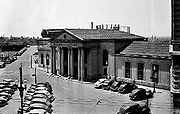
Union Station (Atlanta)
Encyclopedia

Terminal Station (Atlanta)
Terminal Station in Atlanta was the larger of two principal train stations in downtown, Union Station being the other. Opening in 1905, Terminal Station served Southern Railway, Seaboard Air Line, Central of Georgia , and the Atlanta and West Point. The architect was P...
being the other. It was the third "union station
Union station
A union station is the term used for a train station where tracks and facilities are shared by two or more railway companies, allowing passengers to connect conveniently between them...
" or "union depot" (usage varied in the 19th century), succeeding the the 1853 station
Atlanta Union Station (1853)
Atlanta's first Union Station, also known as Union Depot was the original depot of Atlanta, Georgia. It was designed by architect Edward A. Vincent. It stood in the middle of State Square, the city's main square at the time, where Wall Street now is between Pryor Street and Central Avenue...
, burned in the Battle of Atlanta
Battle of Atlanta
The Battle of Atlanta was a battle of the Atlanta Campaign fought during the American Civil War on July 22, 1864, just southeast of Atlanta, Georgia. Continuing their summer campaign to seize the important rail and supply center of Atlanta, Union forces commanded by William T. Sherman overwhelmed...
, and the the 1871 station
Atlanta Union Station (1871)
Atlanta's second Union Station was built in 1871 on the site of the the 1853 station, burned in the Battle of Atlanta. It was built in Second Empire style, designed by architect Max Corput...
.
The station was located over the tracks between Forsyth and Spring Streets, 3 blocks west and 1 block south of the predecessor union stations. The site is the block immediately west of Five Points MARTA station
Five Points (MARTA station)
Five Points is a tri-level underground multi-platform metro station of the Metropolitan Atlanta Rapid Transit Authority rail system. It is the transfer point between the Red and Gold Lines and the Blue and Green Lines and serves as MARTA's transportation hub. It provides access to the Five Points...
.
Opening in 1930, the third Union Station served the Georgia Railroad, Atlantic Coast Line
Atlantic Coast Line Railroad
The Atlantic Coast Line Railroad was an American railroad that existed between 1900 and 1967, when it merged with the Seaboard Air Line Railroad, its long-time rival, to form the Seaboard Coast Line Railroad...
(previously the Atlanta, Birmingham and Coast Railroad
Atlanta, Birmingham and Coast Railroad
The Atlanta, Birmingham and Coast Railroad was organized in 1926 to replace the Atlanta, Birmingham and Atlantic Railway. The AB&C was controlled by the Atlantic Coast Line Railroad, which owned a majority of the stock. In 1946, the AB&C was bought by the ACL and the became the latter company's...
), and Louisville and Nashville (previously the Nashville, Chattanooga and St. Louis Railway
Nashville, Chattanooga and St. Louis Railway
The Nashville, Chattanooga and St. Louis Railway was a railway company operating in the southern United States in Kentucky, Tennessee, Alabama and Georgia...
). It replaced earlier stations on the same site.
After the tenant railroads of Union Station had discontinued all their passenger trains -- the last such train operated on April 30, 1971, the day before Amtrak
Amtrak
The National Railroad Passenger Corporation, doing business as Amtrak , is a government-owned corporation that was organized on May 1, 1971, to provide intercity passenger train service in the United States. "Amtrak" is a portmanteau of the words "America" and "track". It is headquartered at Union...
came into existence -- the station was razed in 1972. Remnants of the platform may be seen behind the Atlanta Journal Constitution building although construction of Underground Atlanta
Underground Atlanta
Underground Atlanta is a shopping and entertainment district in the Five Points neighborhood of downtown Atlanta, Georgia, United States, near the intersection of the east and west MARTA rail lines. First opened in 1969, it takes advantage of the viaducts built over the city's many railroad tracks...
and MARTA
Metropolitan Atlanta Rapid Transit Authority
The Metropolitan Atlanta Rapid Transit Authority or MARTA is the principal rapid-transit system in the Atlanta metropolitan area and the ninth-largest in the United States. Formed in 1971 as strictly a bus system, MARTA operates a network of bus routes linked to a rapid transit system consisting...
largely obliterated the site.

